Get to know the photo book "The Most Beautiful Trails of Patagonia"
Torres del Paine, El Chaltén, Bariloche, Ushuaia, Villarrica, Cerro Castillo, Dientes de Navarino and Parque Patagonia
Paddling around Ilhabela (Brazil) in one day
The place
lhabela, on the Brazilian southeast coast, is one of the largest oceanic islands in Brazil, with 436 km² (168 mi²) and 165 km (102 mi) of coastline. It’s also one of the most beautiful islands, but this article is not about its beauty, since the paddling I made with a sea kayak on 12/12/2018 did not intend to appreciate the landscapes of its beaches, this time I went to the sea trying to find out if I would be able to circumnavigate it in only one day, not having an escort boat and being self-sufficient.
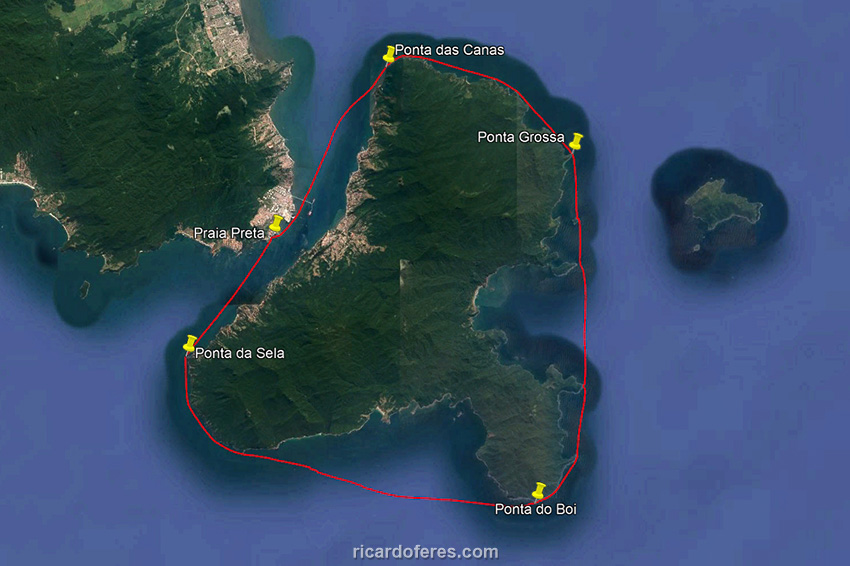
The reasons
Now you’re probably thinking “Why to do this, instead of enjoying the beaches and sleeping some nights on the island?”. No doubt it would be more fun to do in three or four days, as in my first circumnavigation of Ilhabela (read here the article), but now my intention (or pretension, maybe) was to know better my limits as a kayaker, both physically and psychologically. And it’s because of the psychological factor that I decided to do it alone, because if I had an escort boat I would paddle knowing that I could go unti I’d be completely exhausted, and then just entering the escort boat. Being alone it is mandatory to dose the energy expended because if there is a problem, either physical and/or mental exhaustion, I would have to solve it myself, just as I would have to solve any problems related to the environment.
This idea came up on the second day of my first Ilhabela circumnavigation, when I paddled 50 km (31 mi) and felt only a moderate fatigue, which made me curious to know my limit. Then the idea took hold for also training for a much longer and more demanding paddling that I intend to do, but if I didn’t pass this test, I could discard the most ambitious plan I have in mind.
The planning
As I live in São Sebastião, a town in front of Ilhabela, I decided to start from the continent. Although the distance gets a little bigger, the logistics are simpler, as I don’t have to take the ferry during the night or to sleep in the island until the time to start paddling. I chose to leave from Praia Preta do Centro, on the narrowest stretch of São Sebastião Channel.
If I could choose, I would do the circumnavigation in the counter-clockwise direction, because I would cross the stretch with the fewest sheltered points in the first half of the paddling, with more assurance of calm sea and rested body. But if I realize on the way out that the wind and current are taking me to the North, I had already decided that I would do it clockwise, it’s wise don’t fight against the current.
I decided to do this in the summer because although the heat is a wear factor and there are more chances of having to face a lightning storm, the days are longer and I would have to paddle less time in the dark. Despite carrying a strobe attached to the kayak and a headlight, the less time in the dark, the better, because of the risk of an accident with a motor boat. If you think that there are too much reckless car drivers, it’s because you have not seen how many of the boat “pilots” behave.
My sea kayak has two watertight compartments, one on the bow (front) and another on the stern (rear), but to reach them I need to get out of the kayak. As I didn’t intend to stop at any beach, all food, water and gears I had to pack so that I could access without leaving the cockpit. Stock of water and maltodextrin (slow absorption carbohydrate) behind the seat and two bottles on the cockpit for easy access. The food was stored in a sealed bag already in the sequence that would be eaten, so I won’t waste time looking for what I want. Finally, equipment such as GPS, satellite tracker, cell phone, camera, PFD, knife and others, all close to me and in the same place used in training, to be able to catch them even with eyes closed.
Oh, I also took a tent and some extra food in the watertight compartment, in case that I have a problem and need to sleep anywhere.
The trainings
I started to train in August 2018 but in a very inconsistent way. I had 33 days of training during 4.5 months, that is, an average of one training every 4 days. Since this is a challenge of endurance, I have been more concerned about doing long distance workouts than trying to gain strenght. I knew that the greatest chance of giving up would be because of the long time in the kayak, always sitting in the same position. Although the cockpit of my kayak is big and allow me to move my legs, the maximum time I had been in it uninterruptedly had been 9 hours, much less than the 17 hours I was planning.
I realized I was ready when I did a 52-km practice in 9 hours and ended up feeling good. I knew I would have to paddle 35 km more on the day of the challenge and that the sea could be worse, but if I continued to increase the distance of the trainings, I could end up getting injured. Now I only had to wait for the ideal forecast.
The execution
I woke up at 03:30 on 12/11/2018, I put the cheese loaves in the oven, had my breakfast and I went to check the sea. To my disappointment, the sea was not as expected and I had to cancel. I hate to have to postpone anything but I thought I’d wait another day to see if the sea would be calmer. One day was not enough, but two days later, there I was in the sea.
Leg 1
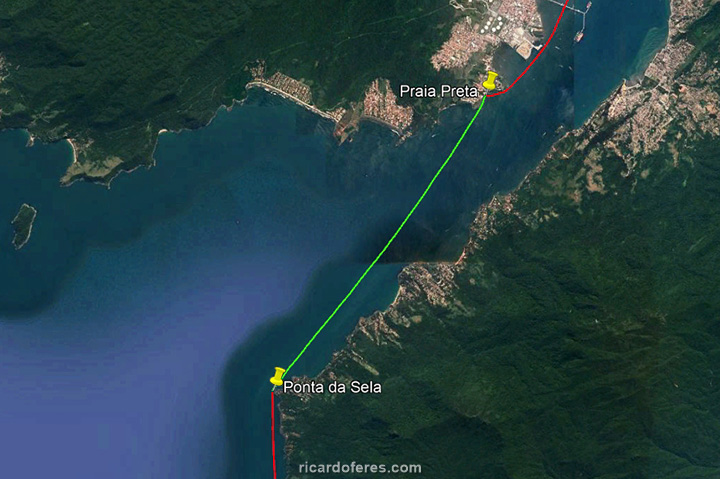
Finally, I woke up once more at 03:30, had my breakfast, I put what was missing in the kayak and started paddling at 04:38 to the south. The current was against and was strong, as almost always within the channel. But on the other side, the wind was favorable, and as at the end of the day, when I entered the channel again, the forecast said that the wind would be favorable, I decided to go south and circumnavigate in a counterclockwise direction.
I pointed the kayak toward the lighthouse at Ponta da Sela and paddled out into the darkness of a moonless night, enjoying the peaceful of the silence broken only by the sound of the kayak cutting the waves and some scared fish that jumped over. After 20 minutes, my eyes were already addapted to the darkness and I noticed that there was a lot of bioluminescence, a phenomenon caused by some types of algae when under stress, such as the contact with the kayak and paddle. Roughly speaking, it’s like watching fireflies in the water, too beautiful! To make it even better, it was happening the Geminid meteor shower and I was fortunate to see 3 shooting stars before the sky began to be bright, about 45 minutes after my departure. No doubt this leg was one of the most beautiful I’ve had in my paddles!
I arrived at Ponta da Sela at 06:08, after paddling for an hour and 31 minutes and leaving 9.1 km (5.6 mi) behind. Average speed of 6 km/h (3.7 mi/h), less than I imagined but nothing to worry about.
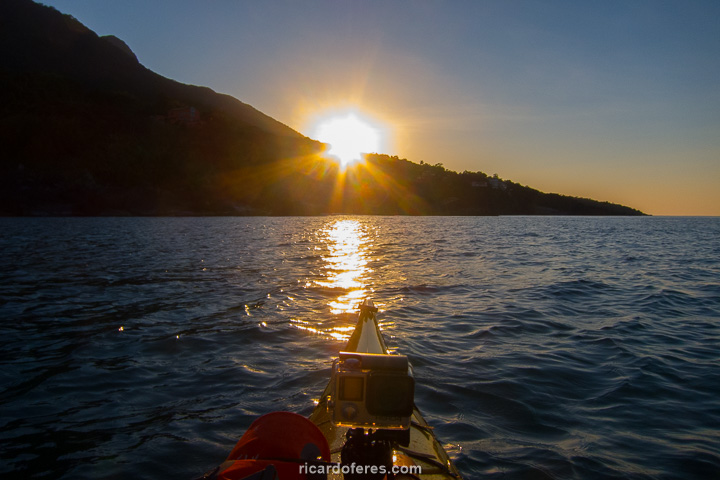
Leg 2
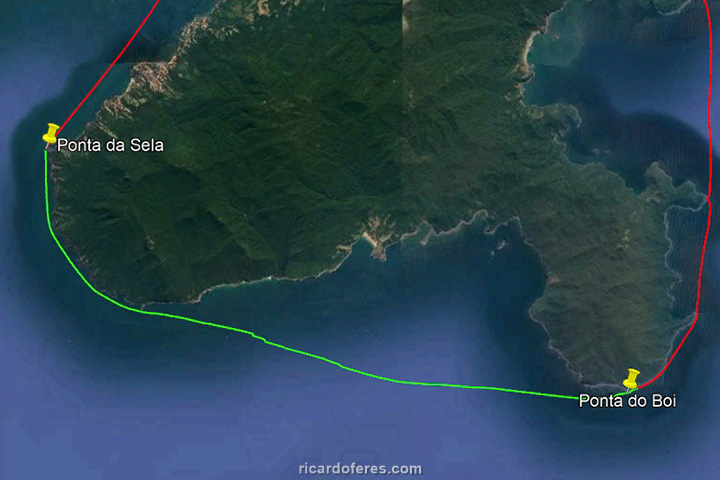
Already in daylight, it was time to see how the waves were in the open sea. And to my grateful surprise, out of the channel the sea was better than inside, the sea was a mirror and there was a very weak lateral wind, which did not help but also did not disturbed me.

Now I was amused by the birds and turtles, who fled only when I was already on their side, as with the silence of the kayak they did not perceive my approach. I also saw some schools of very large fish hunting on the surface. I’m not sure as I could only see the caudal fin when it came out of the water, but because of its shape and size, it should be tunas.
The paddling was performing so well that I did not even stop to eat, so I took the cheese bread to my mouth and paddle while chewing.
This leg had 26.4 km (16.4 mi) that I crossed in 4 hours and 21 minutes, which gives an average speed of 6.1 km/h (3.8 mi/h). Already the average only of the moving time was of 6.8 km/h (4.2 mi/h), what is my usual when current neither wind are helping or disturbing. The total was 35.5 km (22 mi), 5 hours and 52 minutes and an average of 6.1 km/h (3.8 mi/h).
Leg 3
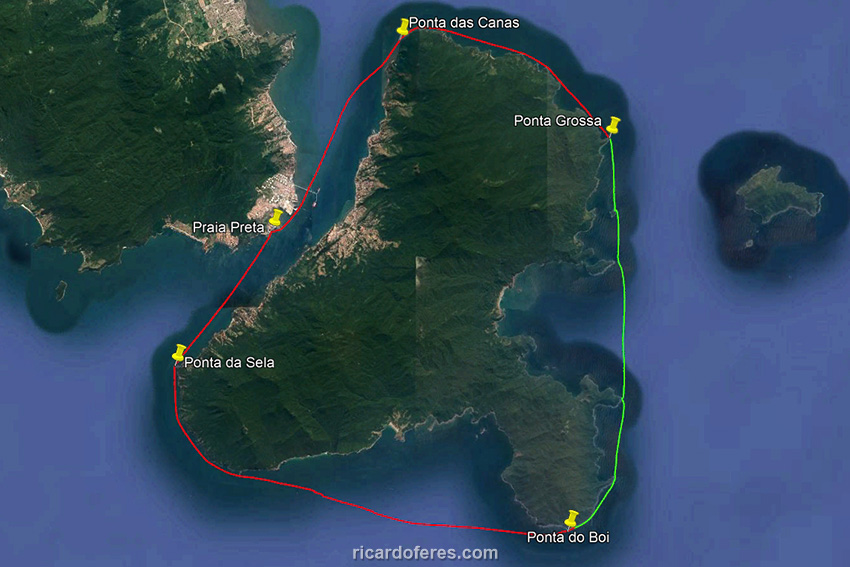
Not long after I crossed Boi Point, the wind began to blow. And it was not any wind … The sea began to rise and the waves were frequent. In the beginning the wind was in my favor, which made me paddle at 10 or 11 km/h (6 or 7 mi/h) for about 20 minutes, but soon the wind changed direction again and it hit me on the left side, causing some waves to pass over the kayak. For those not used to sea kayaks, it is worth mentioning that there is an equipment, called as spray skirt, that is attached to the waist of the rower and to the edge of the cockpit, thus avoiding the entrance of water when a wave passes over the boat. But coming back to the paddling, this wind and waves did not help or disturb my performance, but they avoided me from stopping to eat, drink and even to relieve my bladder, which already looked like a pufferfish.
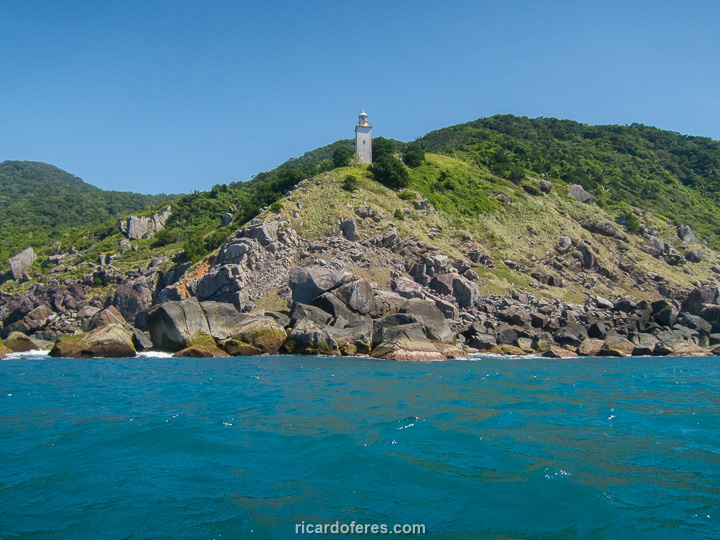
I thought that inside the Pirabura Bay the sea would be calmer but not at all… I kept on repeating the mantra “I’m not thirsty and I do not need to pee”, maybe I would convince my body. To my relief, near Piraçununga Point the sea was very calm and I could stop to solve my problems with liquids and eat something.
As soon as I left the shelter of the rock, the sea was rough and I assume that made me a bit nervous because lately I was not training the rolling, which is the technique used to get back to the paddling position after capsizing. The lack of training was not due to laziness, but because of a strain on the biceps 45 days before. If the kayak capsize, could I turn it up? Or would I have to get out of it, empty the cockpit and go back inside? Thankfully the roll is not 100% but I didn’t have to test it.
As I paddled across Castelhanos Bay, dozens of baby flying fish fled from my kayak, but those who flew into the wind were thrown at me or the kayak, poor babies. Those who took off to the same direction as the wind, were thrown about 20 meters (65 ft) ahead, they must have thought they already know how to fly as adults.
I paddled without pause until I arrived on Serraria Island, where I found a small bay well sheltered and I was able to refill the water bottles, empty my bladder, eat and… Dolphins! Yes, I shouted to myself as I watched a group of them passing within 200 meters (650 ft) of me. I stopped the lunch in the middle and started paddling, but they were also going north and I couldn’t reach them. Even from afar it’s always good to see dolphins, since on my list of cool animals, they are second only to my dogs.
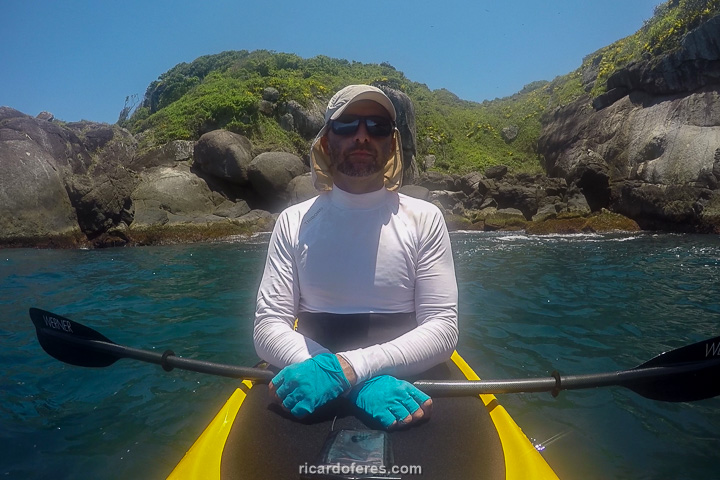
This leg lasted 3 hours and 27 minutes, and for 27 minutes I was stopped. I paddled 23 km (14.3 mi), the average speed was 5.8 km/h (3.6 mi/h) and the moving speed was 6.5 km/h (4 mi/h). In total so far, I paddled 58.5 km (36.3 mi) in 10 hours and 50 minutes, averaging 6.0 km/h (3.7 mi/h).
Leg 4
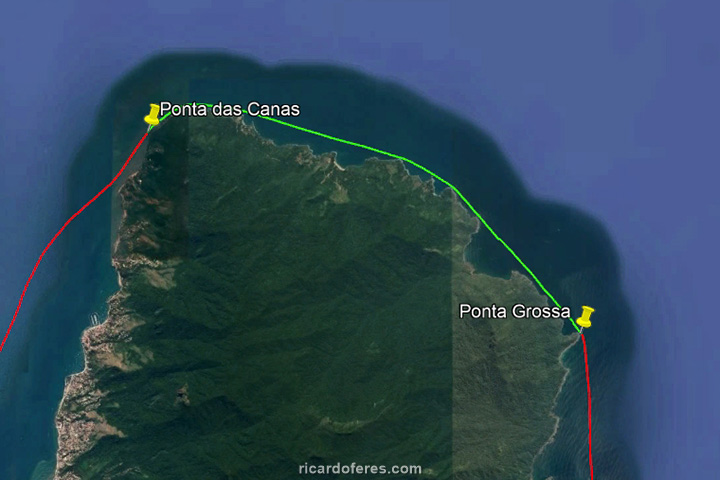
Now I was only 14 km (8.7 mi) distant from the São Sebastião Channel. Once again the forecast was wrong, instead of having a slight wind in favor, I had a slight wind against, but since it was not strong, my pace did not fall much. Besides, I knew that if I got here, I would have no problem finishing the circumnavigation in one day, which made my morale go up.
It was okay until I crossed Fome Beach and started finding tourist boats and boat pilots who insist on speeding 5 meters (15 ft) from the kayak. And the worst is that as it was the end of the day, they were going in the same direction as me, so whenever I heard a boat behind me, I would turn around to find out if he was seeing me. Anyone who has ever asked me if I am afraid to go to the sea or to the mountains alone, knows that my answer is always “I am afraid of people”.
After 2 hours and 48 minutes to cross 14 km (8.7 mi), I arrived in Ponta das Canas, in the north of the São Sebastião Channel, with a total average of 5 km/h (3.1 mi/h) and a moving average of 5.2 km/h (3.2 mi/h). So far, a total of 72.3 km (44.9 mi) traveled in 12 hours and 35 minutes, already 20 km (12.4 mi) more than my largest row so far.
Leg 5
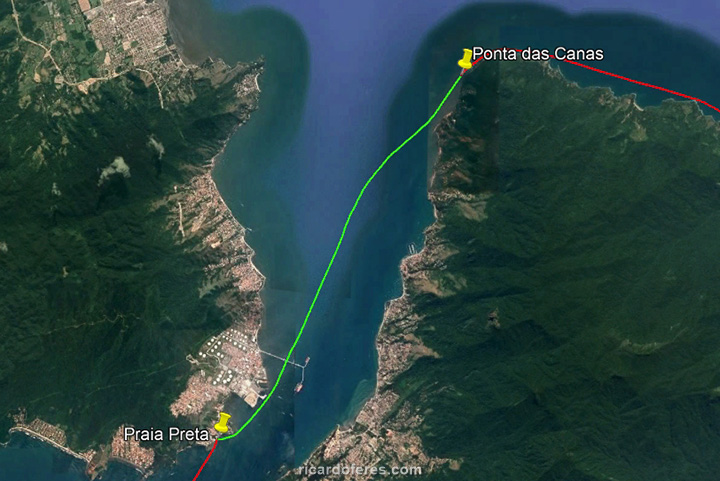
I’m almost there! That’s what I thought when I entered the channel, I just did not expect that the wind forecast was completely wrong again. The wind was strong and it was against me, which added to the contrary current, made my speed to be between 2.5 and 3.5 km/h (1.5 and 1.8 mi/h), even though I was struggling a lot more than in all the previous paddle. You, meteorologist, please do not take it personally, but at that time I cursed you too much, I assume. Anyway, I only had to paddle hard and not stop even to drink water, because when I stopped paddling for only 20 seconds, the kayak was already 4 km/h (2.5 mi/h) in the opposite direction. The sea remained like this for an hour and a half, and on other days I could paddle this whole stretch, from Canas Point to Preta Beach, in an hour and a half.
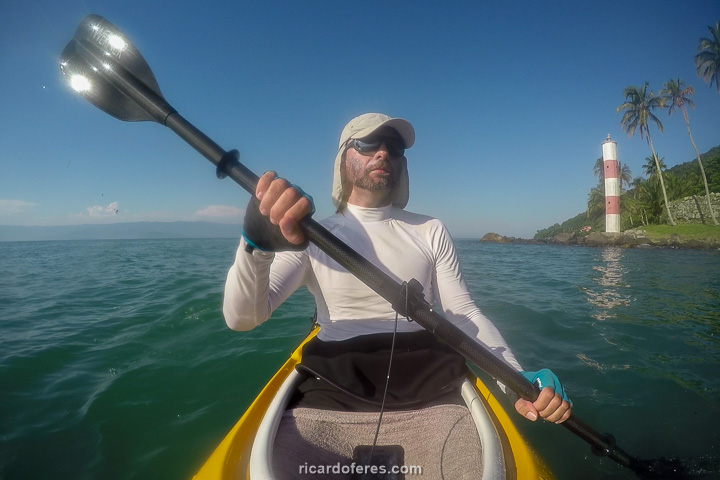
When the wind still calmed down, I had 7 km (4.3 mi) ahead, and having only the current against me, I improved the speed to 5 km/h (3.1 mi/h) and, again, I did not stop to eat because I did not know if the wind would return. It did not come back and I was able to enjoy a beautiful sunset behind the hills of São Sebastião, paddle under the oil terminal, see the city center lighting up and arrive at Praia Preta at 8:22 p.m.
This stretch had 12.9 km (8 mi) traveled in 3 hours and 8 minutes, with an average of 4.1 km/h (2.5 mi/h). In total, my Ilhabela circumnavigation lasted 15 hours and 44 minutes, with a distance of 85.7 km (53.2 mi). Average speed of 5.4 km/h (3.3 mi/h) and the average moving speed of 5.8 km/h (3.6 mi/h). The numbers left me satisfied and already thinking about the next challenge, but surely what I will remember were the shooting stars, bioluminescence, tunas, flying fish, dolphins and the many hours in the company of one of the most beautiful spots of the Brazilian coast, seen from a boat that does not pollute, does not make noise and even better, gives me health. I recommend!
Get to know the photo book "The Most Beautiful Trails of Patagonia"
Torres del Paine, El Chaltén, Bariloche, Ushuaia, Villarrica, Cerro Castillo, Dientes de Navarino and Parque Patagonia
